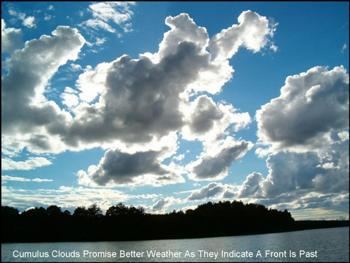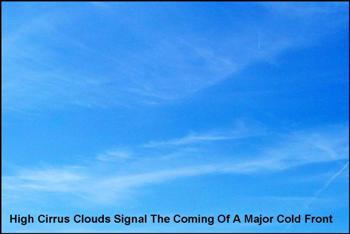Fishing Weather
Conditions That First Affect The Bass, Then The Angler
If you think clear, bluebird sky days are the best fishing weather think again. Those days are usually what follows the passage of a cold front. The mere mention of the "C" and "F" words will make a fisherman drop to his knees and hang his head in despair, pleading, "Oh Lord, please, please, not a cold front!"
Don't get me wrong, bass can be caught on such days, but since the bass undergo a major attitude adjustment it behooves the angler to do the same. In fact, changing weather changes bass behavior, whether it's a cold front, warm front, low or high pressure, rain, wind, you name it, it's that simple.
Fishing weather is the monthly, weekly and daily changes in weather conditions that cause bass to react in specific behaviors that determine where we might locate them.
So let's examine the impact weather changes have on bass and learn how this influences how and where we look for them.

Stable weather, let's consider this condition first. Bass are known to prefer stable, consistent periods of weather, be it sunny, rainy, cold or windy. Stability is the key. Stable weather is fishing weather during which bass are most active and their behavior during different periods of stable conditions probabilistic. That is, bass will engage in specific genetically dictated behaviors during different seasons and weather conditions. The best fishing times usually occur after the third day of a stable weather period. By then, the bass have acclimated to the new conditions and activity levels have stabilized. Bass have returned to their routine seasonal patterns of normal daily activity, feeding and resting.
Rapidly changing weather on the other hand, causes bass to also react rapidly with changes in their feeding, where they choose to locate and even in which senses they utilize to find prey. For example, bass are first and foremost sight feeders. If heavy rains cause wide spread muddy water they will rely more on their hearing and lateral line to feed. Or they may just move to a different area that is clear or less muddy. If the discolored water is not widespread but merely localized around the mouths of creeks or run-off points, bass may move to these areas and assume an ambush position at the edge of the discolored water.

Fronts, Cold and Warm
Cold fronts, fishing weather that is the dread of all fishermen, are masses of cold air that move in replacing warm air usually moving from northwest to the southwest. Temperatures can drop as much as 15° to 25°'s in an hour. There are also shifting or gusty winds and a rapid rise in barometric pressure with cold fronts.

So what is it about a cold front that affects bass? The rise in barometric pressure, literally the weight of the air pushing down on the water. Cold air is heavier than warm air. This heavy air pressing down on the water's surface affects the bass' swim bladder, the organ responsible for a fish being able to suspend or swim in an upright position. Though not an absolute, it is believed this increased pressure discombobulates the bass causing them to lose their sense of balance, become lethargic, even temporarily stop feeding.
On the positive side, for a short period just before the arrival of a cold front bass tend to "feed up", though the window is small. After that, they will "hunker down" in their normal home territory till they become acclimated or the weather changes again.
There is another theory about why bass are affected by cold fronts developed by Doug Hannon, well known as a leading authority on largemouth behavior. His theory is that bass are not "knocked off center" by pressure changes. Instead, the negative impact of pressure changes have significant impact on the fragile creatures found at the lower end of the food chain.
Hannon feels the impact usually thought to affect bass really affects the aquatic insect larvae, fish fry and small crustaceans at the bottom of the food change. These changes in temperature, barometric pressure and increased solar intensity cause these creatures to stop moving around. Once they've stopped moving their predators, small fish, cease to feed and the bass then cease to feed on them. Simply put, the food chain clicks to "pause" till conditions get back to normal.
Whatever the case, cold fronts do little positive toward creating good fishing weather for the angler or the bass. You've heard the term, "lip-locked".
If you are fishing after the recent passage of a cold front search for bass in areas of "structure" where they would move from shallow to deep water. Fish transition areas like river beds, channels, weed edges, gradually sloping points or drop-offs. Use search baits like crankbaits and spinnerbaits till you find them, then fish slow! Jigs, plastics like worms, craws and lizards or slow moving swimbaits are good.
The bass may not actually move to deeper water but they will certainly seek the thickest, "gnarliest" cover they can find in their home area and if available that closest to deeper water. Flipping and pitching jigs and worms up close and personal are good techniques for reaching them.
Look to docks for bass after a cold front. Bass find a great sense of security here and they move far under them rather than staying under the edges as they usually do. Skip light weight lures, such as tubes, under the dock with spinning gear.
A warm front is a mass of warm air replacing cold. These generally move from southwest to northeast bringing warmer, moister air and promise pleasant fishing weather. You will know of its arrival as you will feel the humidity rise.
Warm fronts are a type of fishing weather that doesn't have as severe an impact on bass as do cold fronts. They often move in slowly bringing rain (not storms) and cloud cover. Temperatures rise and barometric pressure drops.
Bass are often stimulated to feed with the arrival of a warm front. They may even venture farther than normal from their "home" range in search of food. Largemouth will be found in the shallows and smallmouth in both shallow and deep water, with deep water being relative to the type water body.
Rain adds oxygen to the water which stimulates bass resulting in their becoming more active. They won't stay put in cover as they do after a cold front. Light rain also blurs the surface of the water reducing the light intensity below. This gives bass a feeling of security that pulls them out of cover. In very clear lakes this important to know. They will be active throughout the day rather than just in the early and late hours of the day. So as far as I'm concerned, a little rain, not a deluge, makes for good fishing weather too.
"Wind, How I Hate Thee."
Don't know about you, but the wind is "not my friend!" I struggle mightily when it is windy not to venture back into the calmer coves and creek arms where boat control and casting are easier. I sadly admit, when it's very windy, I often give in and slink off to a cove out of the wind. Sometimes I'll even stumble upon a new spot I've not fished before that actually has fish. That's all well and good, however, the better fishing is always on the windward side of the lake or reservoir. Why?
The wind may be aggravating the snot out of you above water, buffeting you about, almost tipping you overboard, giving you terrific backlashes and wearing your trolling motor out! But below the surface there is much going on that makes for good fishing weather!
The wind pushes all those little creatures (plankton) the baitfish love against shorelines and the bass follow. The wind creates waves which in turn buffet about the hiding places of food for creatures like crawfish, shad and other crustaceans. In turn, they leave their hiding places to pursue the food. While in pursuit they're out in no-man's land where, surprise, the bass await. And who should be awaiting the bass? That would be us!
Furthermore, the waves hide the noises all we stumble footed anglers make moving around in our boats and stifles the whirring of our trolling motor propellers so the bass don't know we're coming.
When fishing weather is windy "up size" your lures. Big, fat topwaters, spinnerbaits with large blades, heavy jigs of at least 3/8 ounces and crankbaits that can get down easily and keep you in touch with what's going on down under. Forget the dainty stuff. Cast with the wind. Keep your rod close to the water to prevent line bow and consider lighter line.
So, buck up and venture into the wind, as it really is your friend, I guess.

Solunar Cycles, What's With These?
Solunar cycles are considered by many as an important influence on fishing weather. There are in fact solunar tables that many refer to as their guide to the best times to fish.
The entire concept is based on the influence sunrise and sunset, the phases of the moon and tides may have on the daily behavior of wildlife, fish included. I say may, for there are believers and disbelievers of this theory.
As I understand the theory, it's foundation is based on stable weather conditions and to determine the "best fishing times" in your area must be adjusted to include local weather patterns, barometric changes, temperature variations, geologic location and even the position of the moon. Whew, it's all over my head.
Personally, I think the best fishing weather and the best time to fish is whenever you can! So, just go to NOAA's website, check the NOAA weather radar and forecast and if it looks good, no wait, if it just looks safe, GO!
Return to Finding Bass from Fishing Weather
